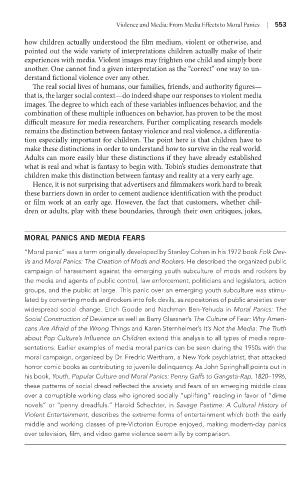Page 574 - Battleground The Media Volume 1 and 2
P. 574
V olence and Med a: From Med a Effects to Moral Pan cs |
how children actually understood the film medium, violent or otherwise, and
pointed out the wide variety of interpretations children actually make of their
experiences with media. Violent images may frighten one child and simply bore
another. One cannot find a given interpretation as the “correct” one way to un-
derstand fictional violence over any other.
The real social lives of humans, our families, friends, and authority figures—
that is, the larger social context—do indeed shape our responses to violent media
images. The degree to which each of these variables influences behavior, and the
combination of these multiple influences on behavior, has proven to be the most
difficult measure for media researchers. Further complicating research models
remains the distinction between fantasy violence and real violence, a differentia-
tion especially important for children. The point here is that children have to
make these distinctions in order to understand how to survive in the real world.
Adults can more easily blur these distinctions if they have already established
what is real and what is fantasy to begin with. Tobin’s studies demonstrate that
children make this distinction between fantasy and reality at a very early age.
Hence, it is not surprising that advertisers and filmmakers work hard to break
these barriers down in order to cement audience identification with the product
or film work at an early age. However, the fact that customers, whether chil-
dren or adults, play with these boundaries, through their own critiques, jokes,
Moral PaniCs and Media Fears
“Moral panic” was a term originally developed by Stanley Cohen in his 1972 book Folk Dev-
ils and Moral Panics: The Creation of Mods and Rockers. He described the organized public
campaign of harassment against the emerging youth subculture of mods and rockers by
the media and agents of public control, law enforcement, politicians and legislators, action
groups, and the public at large. This panic over an emerging youth subculture was stimu-
lated by converting mods and rockers into folk devils, as repositories of public anxieties over
widespread social change. Erich Goode and Nachman Ben-Yehuda in Moral Panics: The
Social Construction of Deviance as well as Barry Glassner’s The Culture of Fear: Why Ameri-
cans Are Afraid of the Wrong Things and Karen Sternheimer’s It’s Not the Media: The Truth
about Pop Culture’s Influence on Children extend this analysis to all types of media repre-
sentations. Earlier examples of media moral panics can be seen during the 1950s with the
moral campaign, organized by Dr. Fredric Wertham, a New York psychiatrist, that attacked
horror comic books as contributing to juvenile delinquency. As John Springhall points out in
his book, Youth, Popular Culture and Moral Panics: Penny Gaffs to Gangsta-Rap, 1820–1996,
these patterns of social dread reflected the anxiety and fears of an emerging middle class
over a corruptible working class who ignored socially “uplifting” reading in favor of “dime
novels” or “penny dreadfuls.” Harold Schechter, in Savage Pastime: A Cultural History of
Violent Entertainment, describes the extreme forms of entertainment which both the early
middle and working classes of pre-Victorian Europe enjoyed, making modern-day panics
over television, film, and video game violence seem silly by comparison.

